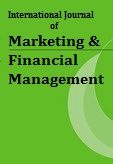ABSTRACT
Purpose: The study aims to assess the levels of financial awareness, access, and engagement among diverse demographic groups in Jabalpur: youth, women, street vendors, businessmen, and those below the poverty line. By exploring financial deepening across these segments, it seeks to identify barriers, challenges, and opportunities for enhancing financial inclusion. The findings can contribute to the field of financial development, informing tailored products, services, and policies to cater to the unique needs of these groups. The research is timely, considering Jabalpur's urbanization and fintech emergence shaping the financial landscape
Methodology: The study employed a qualitative cross-sectional survey design, utilizing stratified random sampling to achieve its objectives, with a sample of 90 respondents from Gwarighat Ward, Jabalpur. It aimed to explore the experiences and challenges faced by youth, women, street vendors, businessmen, and those below the poverty line regarding access to and utilization of financial services. Data were gathered through questionnaires and interviews focusing
on banking access, credit availability, financial literacy, insurance, government program awareness, and the impact of digitalization. Statistical and graphical analysis tools such as graphs, charts, cross-tabulation, and regression were employed to comprehensively understand financial deepening among these population segments.
Findings: The study revealed significant disparities in financial awareness and engagement across occupations and genders in Jabalpur, with substantial gaps among BPL women and students. Policy recommendations included expanding banking access, promoting entrepreneurship, providing targeted financial literacy, encouraging digital payments, addressing gender gaps, and establishing a monitoring framework to foster financial inclusion.
Practical Implications: The study aimed to examine financial awareness among diverse Jabalpur segments, evaluate digital banking's impact on formal financial services access, assess active engagement with financial instruments and markets across these groups, and investigate awareness of government policies and initiatives promoting financial inclusion in Jabalpur.
Originality/Value To validate the novelty of this research, as far as the authors are aware, this is the first study to examine the issues of financial inclusion in Jabalpur.
Type of paper: Research Paper

